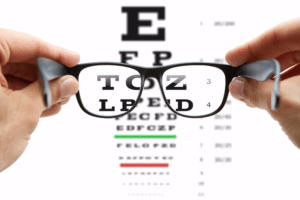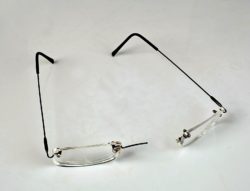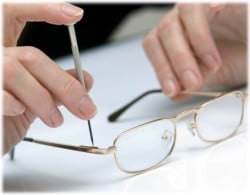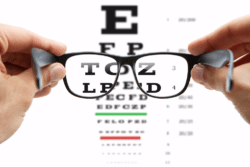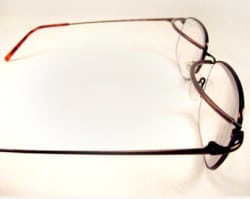Chances are, you or someone you know has some sort of vision impairment. It’s frustrating to be able to read a road sign, but not a label two inches from your face. Not only is it frustrating, it’s inconvenient and confusing. At fixmyglasses.com, we believe that knowledge is power, so to better understand some of the most common eye problems, here are a few simple definitions, symptoms and treatments:
Nearsighted (myopia)
When someone suffers from the vision impairment of nearsightedness, they can see close objects clearly, but objects farther away are blurry and hard to see. Incredibly, almost 30 percent of the U.S. population is nearsighted. Nearsightedness occurs when the eyeball is too long or the cornea (the clear front cover of the eye) is overly curved. As a result, the light entering the eye doesn’t focus correctly. While it can be inherited, nearsightedness can also develop from spending large amounts of time reading, staring at the computer, or doing other close visual work.
Symptoms: Besides, the inability to see far-away objects, other symptoms of nearsightedness includes eye strain, headaches, and fatigue when driving or playing sports. In some cases of nearsightedness, it may only occur at night. With “night myopia,” increased pupil size during dark conditions allows more peripheral, unfocused light rays to enter the eye, therefore making it hard to see distant objects in low light.
Treatment: Eyeglasses are the primary way to correct nearsightedness. A proper corrective lens will decrease the power of the eye’s optics, kind of like a magnifying glass in reverse. For most nearsighted patients, eyeglasses are worn only for specific reasons such as driving, watching a movie or a sporting event.
Farsighted (hyperopia)
For those who are farsighted, distant objects can be seen clearly, but close objects (and especially words) appear out of focus or blurred. This happens when the eyeball is too short or the cornea under curved. Because of this, the eye can’t correctly focus the light when it enters.
Symptoms: Besides, the inability to focus on close objects, other signs of farsightedness can be eye strain, fatigue, headaches, and aching or burning eyes.
Treatment: People who suffer from farsightedness can find relief with corrected eyewear and contact lenses. The corrected lenses alter the way the light enters the eyes, therefore allowing a clearer focus on objects seen closely, while not affecting how distant objects are seen.
In mild cases of farsightedness, eyes may be able to compensate without corrective lenses. In other cases, optometrists will prescribe eyeglasses or contact lenses that alter the way the light enters eyes, allowing for close objects to be seen clearly.
Glaucoma
You’ve most likely heard the word a million times, but you may not really know exactly what glaucoma is. Considering it’s the second-leading cause of blindness in the U.S., it’s important to get familiar with it. Glaucoma is actually a group of disorders leading to progressive damage to the eye’s optic nerve. The loss of nerve tissue results in loss of vision. The most common form of glaucoma is “primary open-angle glaucoma” and develops slowly over time, usually without symptoms. Learn more about glaucoma by visiting www.Glaucoma.org.
Symptoms: As noted above, glaucoma comes on without any obvious symptoms. However, regular screenings can catch optic nerve changes and progressive peripheral vision loss leading to glaucoma. For those with close-angle glaucoma, there may be sudden ocular pain, seeing halos around lights, red eye, high intraocular pressure, nausea and vomiting.
Treatment: You may be surprised to know that there is no cure for glaucoma, and patients with glaucoma need to continue treatment for the rest of their lives. However, early diagnosis and continuing treatment can preserve glaucoma-impaired eyesight. Regular use of prescription eye-drops is the most common and often the first treatment. Some cases may require regular medications, laser treatment or surgery. For more information on glaucoma testing, see our past blog, 7 Answers to Common Eye Exam Questions.
Presbyopia
When the shape of the crystalline of the eye changes, the result is presbyopia. People who suffer from presbyopia have difficulty focusing on close objects and reading small print becomes virtually impossible. While it might seem to come on suddenly, presbyopia is a condition that comes on gradually over time from early childhood.
According to American Optometric Association, presbyopia is not a disease and cannot be prevented. Considered a natural part of the aging process of the eye, presbyopia can also complicate other vision problems such as farsightedness, nearsightedness and astigmatism.
Symptoms: The onset of presbyopia is first noticed by blurred vision at normal reading distance, as well as eye fatigue and headaches for no apparent reason.
Treatment: Most people with presbyopia are prescribed reading glasses, multi-focals or contact lenses. As noted above, if presbyopia is combined with other vision ailments, wearing eyeglasses all the time will probably be a better solution.
Common vision screenings, like the ones at school or pre-employment tests often don’t detect some of these vision ailments. However, a complete and comprehensive optometric examination that includes all the necessary testing should diagnose these common problems and offer treatment options.
For more questions or comments concerning these and other vision impairment needs, contact the professionals at fixmyglasses.com.

